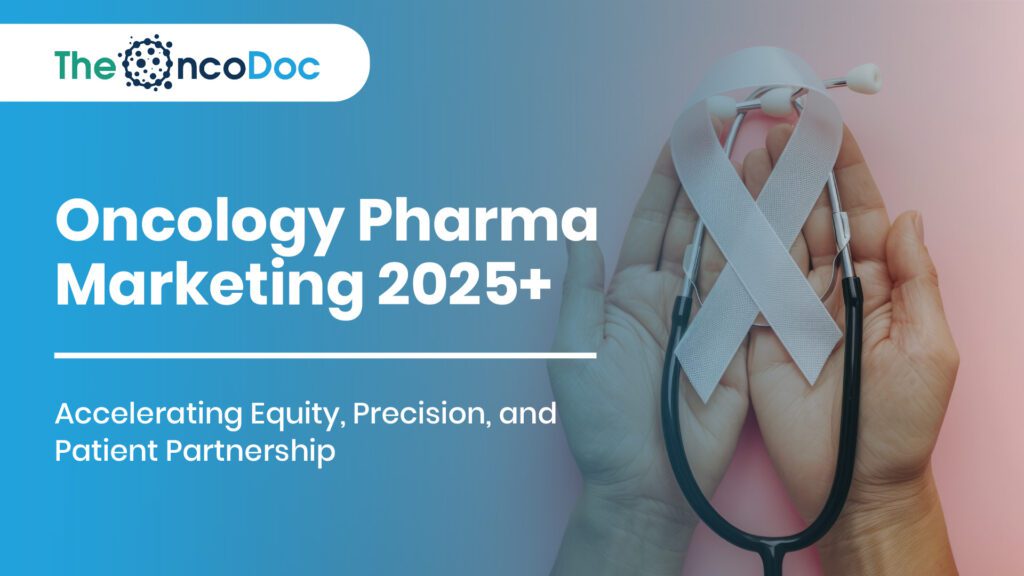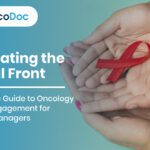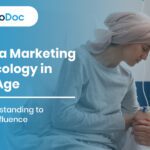Introduction: Redefining Influence in the AI-Powered Oncology Era
As oncology care evolves toward hyper-personalized medicine, pharma marketing must also shift from awareness generation to actionable, trust-based influence. The stakes are higher: cancer incidence is rising globally, early diagnosis remains inconsistent, and oncologists face overwhelming information loads. In this new paradigm, the success of pharmaceutical companies hinges not on promotional reach but on their ability to facilitate health equity, drive behavioral change, and deliver localized value.
In 2025 and beyond, successful oncology pharma marketers are those who integrate technology with empathy, AI with ethics, and data with local culture. This article explores the next-generation strategies transforming oncology marketing, from intelligent segmentation and dynamic KOL networks to post-treatment care models, emotional resonance, and public health integration.
1. Strategic Shift: From Brand-Centric to Patient-Centric Ecosystems
Historically, oncology marketing revolved around product messaging and clinician targeting. Today, patient expectations have changed dramatically. Empowered patients and digitally connected caregivers demand:
- Mobile-first, multilingual content about early symptoms and available diagnostics
- Trustworthy platforms offering unbiased comparisons of therapies
- Peer-led communities that focus on survivorship, side effect management, and hope
Leading brands now build “patient experience journeys” rather than campaigns. This includes personalized information pathways, emotional storytelling, and a deep focus on support, not just treatment promotion.
2. Precision Segmentation: The New Standard of Relevance
Oncology audiences may now be segmented with extreme precision thanks to AI and big data. Rather than relying on age or cancer type alone, pharma companies are grouping audiences by digital behavior, clinical engagement, and informational preference.
This level of granularity allows hyper-targeted messaging. For instance, an oncologist who frequently engages with RWE dashboards may receive interactive tumor board simulations, while a rural GP may receive WhatsApp explainers for faster screening referrals.
3. Engaging GPs and Allied Health for Early Detection
General practitioners and allied health professionals (nurses, health workers) are the first filter in cancer care. Yet, 60% of early cancer symptoms globally go unrecognized at the primary care level.
Pharma is bridging this gap through:
- AI-driven “Clinical Suspicion Score” apps to flag red flag symptoms
- CME modules via voice assistants for low-literacy regions
- Local-language infographics distributed through health worker networks
These tools are credited with raising early detection referrals by up to 33% in underdiagnosed regions.
4. Omnichannel Transformation: A Personalized Touchpoint Matrix
Modern pharma marketing is no longer linear. Instead, it thrives on interconnected micro-moments that engage both clinicians and patients across multiple channels. This includes:
- Smart speakers that deliver daily oncology trivia in clinics
- Interactive kiosks at screening camps with AI chatbots
- Instagram Reels of survivor diaries with embedded booking links
- EHR-integrated nudges for doctors based on patient risk data
Pharma marketers are increasingly creating “orchestrated journeys”, where the message adapts based on who interacts, how, and when.
5. Community-Centered Oncology Campaigns
Urban-centric campaigns no longer suffice. In 2025, oncology pharma must invest in community-grounded programs that reflect local health beliefs, languages, and access barriers.
Examples include:
- Radio drama series in Chhattisgarhi about oral cancer risks in tobacco users
- Bus-wrapping efforts to raise awareness of breast lumps in Tier 3 municipalities
- Local influencers sharing real-time screening experiences via video blogs
Such campaigns increase engagement by 2x compared to generic awareness ads, especially in regions with health literacy gaps.
6. AI-Guided Adaptive Content Engines
Gone are the days of static content calendars. Pharma marketers now use adaptive content engines, which modify content delivery in real-time based on:
- User behavior (time spent, click depth)
- Search histories and social listening
- Location, language, and cancer type trends
For example, a user who skipped two awareness videos but opened a chatbot about “mouth sores” may be redirected to an oral cancer video with subtitles and an interactive FAQ.
These engines increase call-to-action rates by 40% and enhance content retention.
7. Post-Treatment Engagement: Retention Beyond the Cure
Post-treatment care is often neglected in pharma strategy. Yet, survivors face fatigue, nutritional issues, depression, and late toxicities. Brands now support:
- AI-nutrition planners for recovery
- Tele-counseling sessions for emotional wellbeing
- Adherence monitoring apps with voice alerts and reminders
- Survivor ambassador programs that help navigate return to work
In addition to being patient-focused, these connections foster brand loyalty and practical evidence pipelines.
8. Survivor Storytelling: From Testimonials to Health Advocacy
The emotional power of survivor voices is unmatched. Pharma campaigns now train survivors as certified awareness ambassadors, integrating them into campaign design and execution.
Benefits include:
- 45% higher engagement in awareness campaigns featuring survivor moderators
- Increased screening intent in 3 out of 5 patients after hearing peer stories
- Enhanced message retention, especially among first-time listeners
Real and localized storytelling can be used as a public health intervention and as a therapeutic practice.
9. Emotion-Sensing and Sentiment Looping
Pharma marketers are using AI to examine voice recordings and user-generated comments for emotional clues, tone, and sentiment. This allows real-time campaign optimization. For example:
- If fear is dominant, adjust messaging to emphasize survival rates and success stories
- If confusion is detected, insert expert Q&A videos
- If anger or skepticism arises, activate myth-busting content with local KOLs
This feedback loop ensures that emotional resonance aligns with audience psychology.
10. Gamified Tools for Awareness and Screening
Gamification is helping pharma overcome inertia and stigma associated with cancer screening.
Popular features include:
- “Cancer Risk Meter” quizzes with instant feedback
- Community health league tables, encouraging friendly competition in screening
- Streak-based incentives for healthy behaviors tracked via wearable sync
Such tools have boosted screening sign-ups by up to 35%, especially in younger populations and digital-savvy caregivers.
11. Predictive Campaigning and Real-Time Deployments
AI-powered predictive engines now alert pharma teams about potential spikes in specific cancer types, based on:
- Symptom search surges
- EHR clustering
- Public health data trends
Example: A rise in “breast lump” searches in Rajasthan’s Alwar district triggered a localized campaign within 72 hours, involving mobile mammography vans, influencer videos, and radio PSAs.
12. KPIs Reimagined: From Reach to Real Impact
Pharma’s success metrics are evolving. It’s no longer about impressions, but health outcomes and behavior shifts.
Marketers must integrate CRM platforms with real-world impact dashboards to justify ROI, and patient value.
13. Collaborations with NGOs and Public Health Missions
In 2025, meaningful campaigns happen in partnership with:
- ASHA workers for rural reach
- State NCD cells for access to epidemiological data
- NGOs for ground-level execution
- Academic hospitals for evidence generation
Such partnerships reduce operational burden and improve legitimacy, especially in low-trust or underserved geographies.
14. KOL Networks: The Rise of Micro-Influencers
Large national KOLs are being replaced, or supplemented, by hyperlocal micro-KOLs. These include:
- Regional oncologists with WhatsApp credibility
- Survivors with grassroots networks
- Pharmacists or diagnostic technicians in Tier 3 districts
These influencers are authentic, accessible, and culturally synchronized with their communities.
15. AR, VR, and 3D Learning for HCPs
Augmented Reality (AR), Virtual Reality (VR), and 3D simulation technologies are revolutionizing how healthcare providers (HCPs) learn and stay updated. Pharma companies are now developing immersive educational tools such as:
• 3D visualizations of tumor biology to enhance disease understanding
• Interactive drug mechanism modules for hands-on pharmacological learning
• VR-based Continuing Medical Education (CME) sessions tailored to complex or rare oncology cases
These innovations transform traditional learning into engaging, experiential journeys, making clinical concepts more intuitive and memorable. Importantly, they allow HCPs to practice decision-making in realistic virtual environments, improving preparedness and confidence.
By offering such advanced tools, pharma brands elevate their role from product promoters to knowledge partners, supporting ongoing medical education. This shift not only enhances clinical proficiency but also builds lasting trust and value within the healthcare community.
16. Smart Chatbots and IVR for Mass Education
In linguistically diverse nations like India, chatbots and IVR (Interactive Voice Response) are unlocking health education at scale.
Applications include:
- Voice-based cancer FAQs in 12+ Indian languages
- Symptom checkers integrated into WhatsApp
- Interactive IVR tools for scheduling screenings
These technologies are bridging the digital divide with simplicity and empathy.
17. Publicly Shared Dashboards and Transparency
Forward-thinking pharma companies are embracing radical transparency by launching publicly accessible dashboards that showcase the tangible impact of their oncology initiatives. These platforms display real-time data on:
• Screening participation rates segmented by region or demographic
• Advancements in early detection patterns brought about by awareness initiatives
• Quantifiable campaign outcomes, such as engagement, referrals, or tool usage
• Growth in survivor community involvement and long-term patient support metrics
By opening this data to healthcare professionals, patient groups, and policymakers, pharma brands foster a culture of accountability and shared ownership in cancer care progress. These dashboards demonstrate that marketing is no longer just about reach, it’s about results that matter.
Moreover, visibility into outcomes encourages continuous optimization of campaigns based on what’s truly effective in the field. It also invites constructive partnerships with NGOs, government agencies, and local health bodies by offering credible, actionable insights.
Ultimately, public dashboards move pharma beyond performance claims into measurable public health contribution. They not only build trust with stakeholders but also reinforce the industry’s commitment to transparency, impact, and evidence-based marketing that drives real-world change.
18. Real-World Evidence as a Marketing Narrative
Pharma marketing is evolving from trial-centric promotion to storytelling grounded in real-world evidence (RWE). In today’s outcomes-focused healthcare environment, brands are moving beyond clinical trial efficacy to highlight the actual patient impact seen in everyday settings.
Marketing narratives now center around tangible metrics such as:
• The percentage of patients who successfully return to work post-treatment
• Functional improvements, like enhanced mobility and reduced fatigue levels
• Decrease in recurrence rates linked to adherence-support technologies
These RWE-driven insights resonate deeply with a broader set of stakeholders, including payers, policymakers, and patient advocacy groups, who demand proof of long-term value, not just clinical promise.
By showcasing real-life health benefits and improved quality of life outcomes, pharma companies strengthen their credibility and make a compelling case for formulary inclusion, reimbursement approvals, and wider therapeutic adoption.
This shift toward lived experience data allows marketers to humanize their messaging while also aligning with global healthcare’s push toward value-based care. In short, real-world evidence isn’t just supporting the brand story, it is becoming the story.
19. Personal Health Twins and Dynamic Profiling
Innovative pharma brands are embracing the next frontier of personalization through digital health twins, virtual models of individual patients that mirror their clinical profiles, behavioral tendencies, and content interaction patterns. These AI-generated avatars simulate how real patients might respond to therapies, engage with educational tools, or adhere to treatment plans.
Digital health twins are driving new levels of marketing precision by enabling:
• Tailored risk communication based on predicted disease progression or lifestyle impact
• Behavioral intervention strategies designed to preemptively address non-adherence
• Smart content sequencing, where educational materials adapt in real time to individual learning preferences
This data-driven dynamic profiling ensures that every touchpoint, whether digital or human, is more relevant, empathetic, and clinically aligned. By understanding the patient’s virtual twin, marketers can anticipate needs and deliver hyper-personalized experiences that foster trust and improve outcomes.
Moreover, the use of health twins supports ethical marketing by focusing on supportive care and shared decision-making, not just product promotion. It shifts the conversation from one-size-fits-all messaging to real-time, patient-aware communication, marking a powerful evolution in how pharma interacts with people, not just populations.
20. Emotional Equity as Brand Differentiator
Finally, brands are now differentiated less by drug pipelines and more by emotional equity, how much people trust them, feel supported by them, and talk about them positively.
Measuring emotional equity includes:
- Net Emotional Resonance Score (NERS)
- Patient Advocacy Mentions
- Emotional Retention in Video Content
Emotional design is the new competitive advantage.
Conclusion: The Oncology Marketer as a Health Architect
Oncology pharma marketing in 2025+ is no longer a business function, it’s a public health catalyst. Success now lies in precision without exclusion, technology with empathy, and messages that heal, not just sell.
By aligning with public health goals, embracing digital-first personalization, and honoring the emotional complexity of cancer, pharma marketers have a historic opportunity: not just to influence decisions, but to transform destinies.
The Oncodoc team is a group of passionate healthcare and marketing professionals dedicated to delivering accurate, engaging, and impactful content. With expertise across medical research, digital strategy, and clinical communication, the team focuses on empowering healthcare professionals and patients alike. Through evidence-based insights and innovative storytelling, Hidoc aims to bridge the gap between medicine and digital engagement, promoting wellness and informed decision-making.



